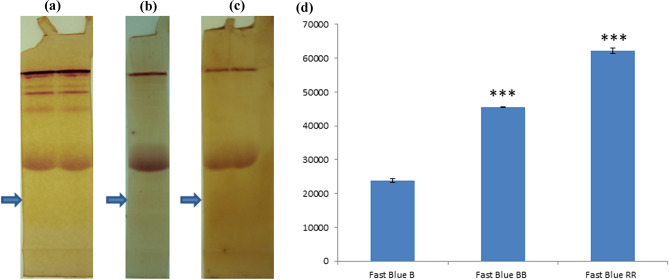Dear Editor
Staining of the esterase activity of plasma proteins on a gel is practised in the biological laboratory [1, 2]. 1-Naphtyl acetate and 2-Naphthyl acetate (2NA) are known substrates for the detection of esterase activity with plasma proteins [1–4]. Overnight staining of the gel following an electrophoresis run detects the products formed (i.e. Naphthols) due to the esterase activity of plasma proteins in the gels with suitable azo dyes [4, 5]. However, it is not well established that which dye is better for the detection of products. Nothing confirmatory is documented without the background staining as well.
In this context, we have performed the detection of products of 2NA (75 µM) on Native Polyacrylamide gel electrophoresis (PAGE) using azo dyes (0.12%), i.e. Fast Blue B, Fast Blue BB, and Fast Blue RR. Details of the procedure are available at reference number 4. We have observed that the background staining of the gel with Fast Blue B is significantly less (p value < 0.0001) in comparison to Fast Blue BB and Fast Blue RR. Of these Fast Blue RR shows maximum background staining (Fig. 1). The banding pattern is also different with different dyes. It is well known that the dye with minor background staining is advantageous than its counterparts.
Fig. 1.
Representative picture of native PAGE of plasma proteins followed by staining with 2NA for detection of esterase activity. The gel is incubated with 75 µM 2NA in the solution of a Fast Blue B (0.12%), b Fast Blue BB (0.12%), c Fast Blue RR (0.12%) for overnight staining respectively. The densitometry analysis of the background of the gel (→). Mean ± SD (n = 6) of the background density is shown in d for (A), (B) and (C) respectively (Y-axis in square pixel where 96 pixels = 1 inch). ***p value less than 0.0001
Therefore, we feel that for the detection of products of 2NA on Native PAGE, Fast Blue B dye must be considered for its less background staining in comparison to Fast Blue BB and Fast Blue RR.
Acknowledgement
DK acknowledges Council of Scientific and Industrial Research, India for providing fellowship (File No: 09/141(0197)/2016-EMR-I). DB acknowledges the Department of Science and Technology (DST), New Delhi for financial assistance.
Abbrivations
- 2NA
2-Naphthyl acetate
- PAGE
Polyacrylamide gel electrophoresis
Compliance with Ethical Standards
Conflict of interest
The authors declare that they have no conflict of interest.
Footnotes
Publisher's Note
Springer Nature remains neutral with regard to jurisdictional claims in published maps and institutional affiliations.
References
- 1.Ahmad A, Ahmad R. In-gel detection of esterase-like albumin activity: characterization of esterase-free sera albumin and its putative role as non-invasive biomarker of hepatic fibrosis. Arabian J Chem. 2017;10:673–682. doi: 10.1016/j.arabjc.2014.10.016. [DOI] [Google Scholar]
- 2.Nagpal N, Chowdhary S, Bhattacharyya R, Banerjee D. A color-reaction-based rapid screening for null activity of butyrylcholinesterase: a step toward point-of-care screening for succinylcholine apnea: Rapid Screening for Null Butyrylcholinesterase. Biotechnol Appl Biochem. 2015;62:154–163. doi: 10.1002/bab.1252. [DOI] [PubMed] [Google Scholar]
- 3.Li B, Sedlacek M, Manoharan I, Boopathy R, Duysen EG, Masson P, et al. Butyrylcholinesterase, paraoxonase, and albumin esterase, but not carboxylesterase, are present in human plasma. Biochem Pharmacol. 2005;70:1673–1684. doi: 10.1016/j.bcp.2005.09.002. [DOI] [PubMed] [Google Scholar]
- 4.Kumar D, Behal S, Bhattacharyya R, Banerjee D. β-Naphthyl acetate in acetone produces a dark background for staining of esterase activity on gel. Ind J Clin Biochem. 2019;34:240–242. doi: 10.1007/s12291-018-0769-3. [DOI] [PMC free article] [PubMed] [Google Scholar]
- 5.Chowdhary S, Bhattacharyya R, Banerjee D. 1-Naphthyl acetate as an alternative substrate of hemolysate cholinesterase: Direct visualization of enzyme activity within 10 minutes on polyacrylamide gels. IJEB. 2019;57:662-671. http://nopr.niscair.res.in/handle/123456789/50453.



